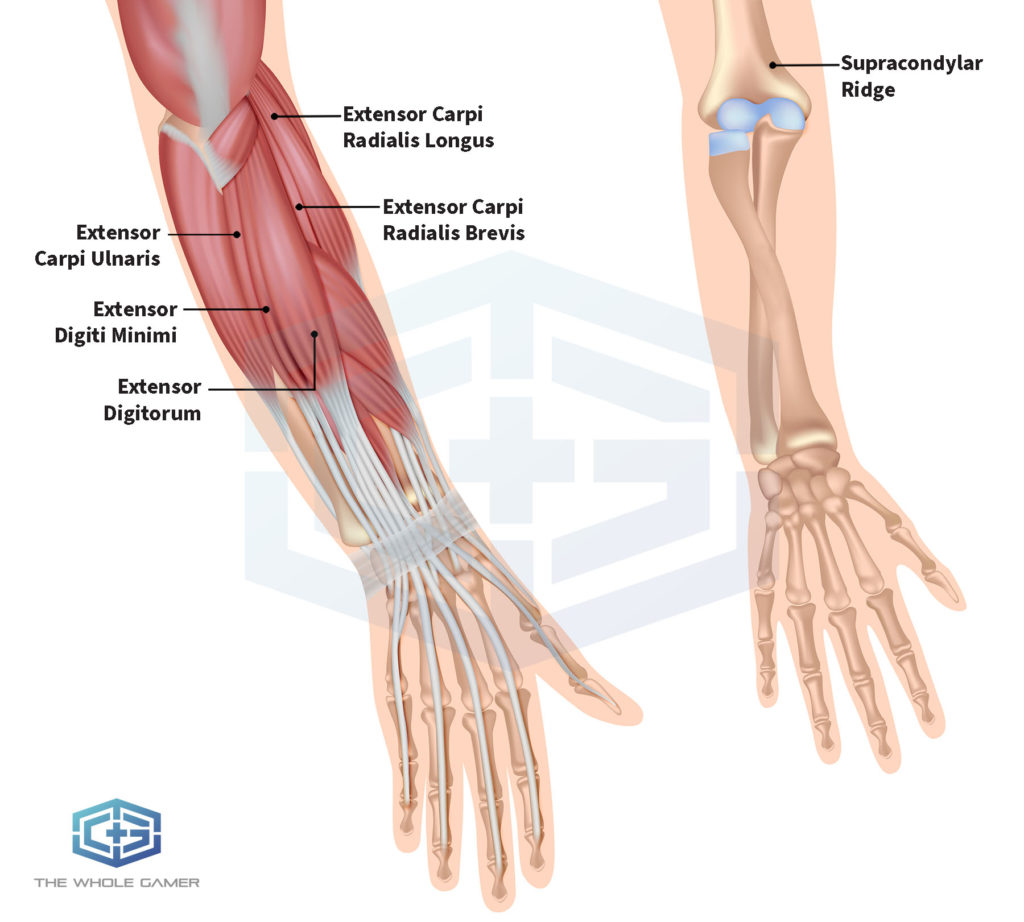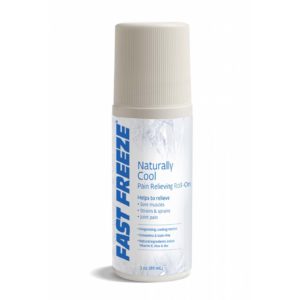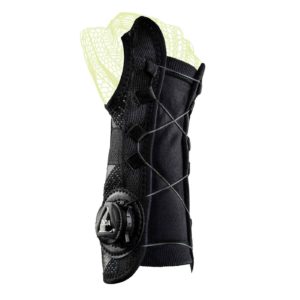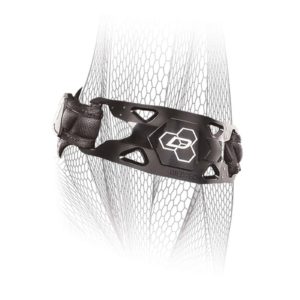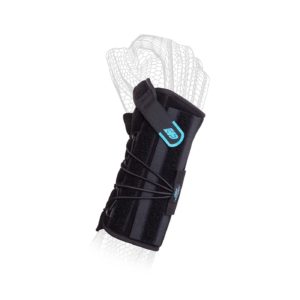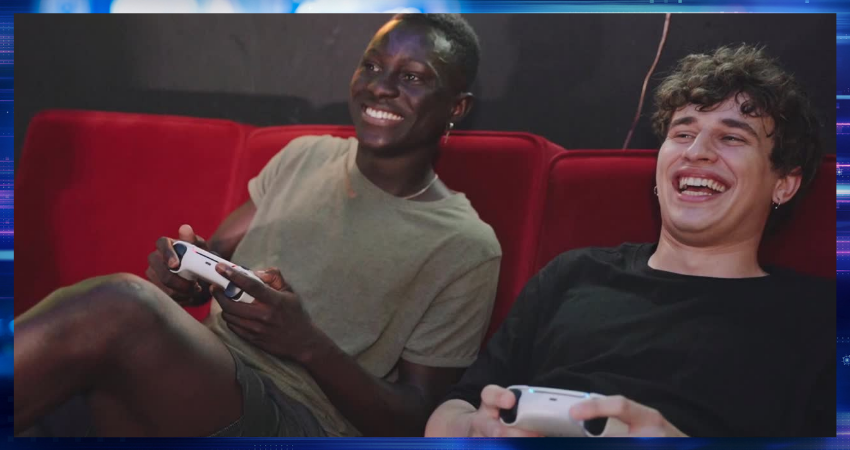
Oct 15, 2021 | Gaming and Your Body
Esports professionals and gaming enthusiasts often spend hours navigating complex games with increasingly challenging levels. This gradually takes a toll on the body, leading to a number of common gaming injuries. Console gamers frequently experience hand injuries, while PC gamers usually develop wrist problems. All avid gamers typically experience some form of back pain.
Common Types of Injuries
Gamer Hand Pain
Gamer’s thumb (De Quervain’s Tenosynovitis) is an overuse injury that develops when tendons in the thumb and wrist become inflamed. It’s caused by repetitive thumb strain [1]. The symptoms include: pain in the hand, thumb, and wrist that worsens with movement; a popping sensation when the thumb is moved; and swelling in the lower region of the thumb.
Ulnar nerve irritation (Cubital tunnel syndrome) is a syndrome that develops due to pressure, stretching, or inflammation of the ulnar nerve where it passes through the cubital tunnel in the elbow [2]. The pain reflects hitting the funny bone. It’s caused by holding the arms and hands in the same position (prolonged elbow flexion) while tightly gripping a controller for extended periods. Pressing the elbows against an armrest or the knees increases the risk of ulnar nerve irritation. The symptoms include: aching pain in the elbow; numbness or tingling in the ring finger and pinky; and hand weakness (loss of grip).
Gamer Wrist Pain
Carpal tunnel syndrome (Median nerve compression) is a syndrome that develops when the median nerve that runs through the carpal tunnel becomes compressed [3]. It’s caused by repeatedly gripping a controller or mouse while gaming. This activity leads to overuse of the tendons and is most prevalent in gamers who play computer video games.
The symptoms of carpal tunnel syndrome include: pain, numbness, burning, tingling, and weakness in the wrist and hand; pins and needles in the hand; and pain that extends toward the elbow.
Keyboard wrist pain – pain, irritation, or inflammation of the tendons in the wrist due to repetitive movements. It’s caused by performing the same hand movements repeatedly during long hours of continuous gaming. This type of pain is more common in PC gamers. The symptoms include: aching pain in the wrist that worsens during or after activity, swelling of the wrist, and joint stiffness [1, 2].
Gamer Back Pain
Sciatica is a painful condition that results from the irritation or compression of the sciatic nerve in the gluteal (buttocks) region. It’s caused by inflammation of the piriformis muscle, which is a hip muscle that runs along the same region as the sciatic nerve [4]. The symptoms include: sharp, shooting pain or burning in the lower back, buttocks, thigh, lower leg, or foot; numbness, tingling, or pins and needles in the back or legs.
Other Common Gaming Injuries
Mouse elbow (lateral epicondylitis or tendinopathy) is the development of pain in the extensor tendons of the forearm. These tendons surround the lateral epicondyle, which is a bony structure on the side of the elbow. The extensor muscles that enable the wrists to bend and the hand to open may be also affected. However, lateral epicondylitis is described as a tendinopathy (painful condition of the tendons) because it doesn’t usually cause substantial inflammation [6, 7].
Mouse elbow is caused by constantly pressing or holding the keys on the mouse while moving the arm as this repetitive motion of shifting, squeezing, and gripping the mouse can make extensor tendons and muscles in the forearm fatigued and weak. The symptoms include: elbow pain, wrist pain while using a mouse, pain while bending or flexing the fingers, and mild inflammation immediately following the injury.
Neck strain – a type of pain associated with looking at a screen (e.g., a monitor) for long periods of time. It’s caused by subconsciously leaning forward while gaming [1, 2]. This incorrect posture increases the weight of the head, which places excessive pressure on the neck. Bending the head forward can increase the weight of the head by about five times its regular weight. This may also damage nerves, muscles, and ligaments in the neck.
Eye strain – fatigue or eye pain that develops when the eye muscles (intraocular and extraocular muscles) are overworked. It’s caused by a limited area of gaze and short, static focal distance that accompanies long hours of staring at a screen while gaming [5]. The symptoms include: eye pain, fatigue, blurred vision, headaches, double vision, dry eyes, burning or stinging, sensitivity to light, eye redness, and strained nighttime vision.
Blood clots (Gamer’s thrombosis) – deep vein thrombosis, which refers to the formation of blood clots in the legs from sitting for long hours while gaming [8]. Sitting for too long reduces proper blood circulation as this causes coagulation of blood in the veins that leads to clots that can break apart and travel to different parts of the body (e.g., lung, heart) where they can become lodged. This may result in a life-threatening situation if the clot significantly restricts blood flow. The symptoms include: pain and swelling in the leg, warm skin, lower leg cramping, or skin discoloration.
Poor posture, core weakness, and poor balance – incorrect body positioning that accompanies extended hours of gaming [5, 8-10]. Many gamers bend forward or slouch while sitting for long periods of time. Gaming devices such as the mouse, controller, and monitor also cause gamers to hold certain body parts (e.g., wrists, hands, elbows, and head) in fixed positions for hours at a time. The symptoms of poor posture include: body pain, reduced blood circulation, joint stiffness and weakness, and muscle, ligament, tendon, or bone damage.
Mouse shoulder – a condition that develops in the proximal tendon of the biceps brachii muscle. This muscle promotes shoulder and elbow flexion. It is caused by misuse or overuse of the shoulder that leads to an imbalance of the fiber orientation in the proximal tendon. Accordingly, the injury is referred to as tendinopathy, which reflects pain due to dysfunction rather than inflammation [9]. This injury is common in PC gamers. The symptoms include: pain in front of the shoulder or the upper arm; an increase in pain when the shoulder is raised upward and forward; discomfort when the arm is moved backwards; and shoulder weakness.
Repetitive motion pain – reflects a group of muscular conditions that develop due to repeated motions that accompany gaming. The pain is caused by uninterrupted repetitive actions, muscle fatigue, incorrect posture, and awkward or unnatural movements (e.g., overextension, twisting the wrist or arm). This form of pain includes discomfort caused by tendonitis, trigger finger, carpal tunnel syndrome, etc. The symptoms include: pain, numbness, tingling, redness or swelling of the affected area, which are most commonly the wrists, hands, elbows, neck, back, and shoulders [9, 10].
Prevention Is the Best Cure
Take a Break
Taking frequent breaks is one of the most important ways to prevent common gaming injuries. Stretching exercises during breaks is another useful strategy. For those who experience recurring injuries, a physical therapist may recommend wearing a wrist splint and hand brace for stabilization. These devices decrease the amount of pressure placed on the hand, wrist, arm, and elbow during movement [1-4].
Ice Packs
Minor repetitive stress injuries can be treated by icing an injured hand, wrist, or thumb to target swelling, inflammation, and pain [4, 6]. It’s easy to use an ice pack during a break or after a long gaming session.
Over-the-Counter Painkillers
Minor repetitive stress injuries can also be treated with non-steroidal anti-inflammatory drugs (NSAIDs) such as aspirin or ibuprofen [4, 6].
Therapeutic Massage
Therapeutic massage is beneficial for targeting or preventing gaming injuries. This form of treatment boosts the circulation of nutrients and oxygen that promote the rejuvenation of inflamed or damaged tissue. It also helps flush away toxins that are linked to gaming-induced inflammation. Receiving therapeutic massages regularly lessens tension in muscles, tendons, and ligaments. In addition, this approach helps break down scar tissue, allows muscles to regain strength, and lowers the risk of recurring injuries.
Working closely with a physical therapist can ensure that the appropriate massage techniques are performed. Incorporating positional changes that support proper hand and body positioning also helps reduce the incidence of back pain as well as repetitive strain injuries.
Good Posture
Finding ways to avoid poor posture while gaming is also beneficial. Slouching can be corrected by firmly pressing the back against a chair until sitting upright becomes a habit [1-3].
Overall, trying to keep the hands and body in a neutral position while gaming, taking frequent breaks, and practicing stretching exercises can help lower the risk of common gaming injuries.
References
- Helliwell PS, Taylor WJ. Repetitive strain injury. Postgrad Med J. 2004;80(946):438-43.
- van Tulder M, Malmivaara A, Koes B. Repetitive strain injury. Lancet. 2007; 369(9575):1815-22.
- Bhanderi DJ, et al. Computer Use and Carpal Tunnel Syndrome: A Case-control Study. Indian J Occup Environ Med. 2017;21(3):109-114.
- Jankovic D, Peng P, van Zundert A. Brief review: Piriformis syndrome: Etiology, diagnosis, and management. Can J Anesth. 2013; 60:1003-12.
- Randolph SA. Computer vision syndrome. Workplace Health Saf. 2017 Jul;65(7):328.
- Kahlenberg CA, et al. New Developments in the Use of Biologics and Other Modalities in the Management of Lateral Epicondylitis. Biomed Res Int. 2015; 2015: 439309.
- Andres BM, et al. Treatment of Tendinopathy: What Works, What Does Not, and What is on the Horizon. Clin Orthop Relat Res. 2008;466(7):1539-1554.
- Rambaran KA, Alzghari SK. Gamer’s Thrombosis: A Review of Published Reports. Ochsner Journal. 2020;20(2):182-186.
- Ratzlaff CR, Gillies JH, Koehoorn MW. Work-related repetitive strain injury and leisure-time physical activity. Arthritis Rheum. 2007;57(3):495-500.
- Tjepkema M. Repetitive strain injury. Health Rep. 2003;14(4):11-30.
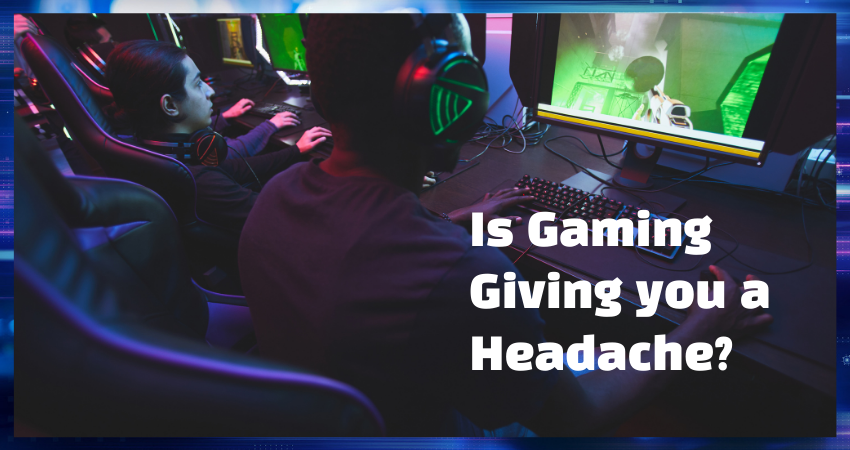
Aug 20, 2021 | Gaming and Your Body
When you’re in the middle of a gaming marathon, you’re probably sitting slouched in front of a TV or computer. You may even subconsciously tilt your head forward to get a closer view of the screen. This can compress nerves in your neck [1]. If this poor posture persists, it can make gaming a real headache. [3]. In other words, this posture can lead to tension headaches, neck pain, fatigue, poor concentration, and muscle tension [2]. Other gaming habits that may contribute to headaches include eye strain, a lack of sleep, stress, a poor diet, and fatigue.
How Poor Posture Hurts
When your head is straight, the levator scapulae and trapezius muscles in the back easily support the weight of your head and neck. Alternately, when your head is tilted toward a TV or computer screen the weight of your head and neck increases. This may overextend your deep neck flexors muscles. Over time, this can lead to a stiff neck, shoulder discomfort, back problems, and pain in the pectorals. Spinal bones in the neck area may even become damaged making it hard to turn your head properly.
As a result, some gamers may develop upper crossed syndrome. Symptoms include persistent pain after sitting in a forward head position too long, or pain after slouching in a chair for lengthy periods. When you slouch instead of pressing your lower back against the back of the chair, the back shifts forward and your shoulders lean against the chair back. The extra tension on your shoulder muscles can cause shoulder pain[4].
Slouching can also lead to joint degeneration in your lower spine as poor posture stretches spinal ligaments as well as lower back and hip muscles (e.g., lumbar erector spinae, gluteus, iliopsoas) beyond a healthy limit. Poor posture can further worsen this condition by straining spinal discs, causing disc bulging or abnormal disc pressure (herniated disc).
Keyboards, controllers… The types of gaming devices you use can also affect your body position and cause poor posture. For example, gamers who use a keyboard tend to curl their upper bodies and head forward. They’re also more likely to use their thumb, finger and wrist muscles. Conversely, eSports professionals or gamers who use console controllers tend to lean back and slouch. In both cases, poor posture is linked to upper body pain. The combination of poor posture with the repeated use of hand and finger muscles increases your risk of developing musculoskeletal disorders [4, 5]. In most cases, the irritation of nerves or muscles in the neck region is the primary cause of chronic pain [6].
How Good Posture Helps
Good gaming posture—sitting in an upright position—helps increase energy levels, while decreasing frustration and restlessness [1]. This means that good gaming posture doesn’t just reduce your risk of pain. It also boosts your overall performance.
Improve Posture, Reduce Pain
So how do you avoid poor posture while gaming? Here are some helpful tips, tailored to your gaming style.
Leaners
Do you often lean towards the screen, tilting your head forward? Try applying therapeutic tape to both sides of your neck. This will help keep your head and neck upright [7].
Slouchers
If you’re a sloucher, practice pressing your back firmly against the chair until sitting in an upright position becomes a habit.
Play Your Best Game
So now you know why chronic head, neck or shoulder pain makes it hard to enjoy gaming or eSports and impacts your performance [1, 4]. You also know poor posture can even lead to serious musculoskeletal problems that prevent you from playing at all. Well, knowledge is power! Use our products to improve your posture, maintain your health, and always play your best game!
References
- Harvey R. The effect of head and neck position on head rotation, cervical muscle tension, and symptoms. Biofeedback. 2018;46(3):65-71.
- Bader EE. The psychology and neurobiology of mediation. CJCR. 2015;17:363-392.
- Fernandez-de-Las-Penas C, Alonso-Blanco C, Cuadrado ML, Pareja JA. Forward head posture and neck mobility in chronic tension-type headache: A blinded, controlled study. Cephalalgia. 2006;26(3):314-319.
- Kietrys DM, et al. Mobile input device type, texting style and screen size influence upper extremity and trapezius muscle activity, and cervical posture while texting. Appl Ergon. 2015;50:98-104.
- Nahar S, Sayed A. Prevalence of musculoskeletal dysfunction in computer science students and analysis of workstation characteristics—An explorative study. IJARCS. 2018;9(2):21-27.
- Xie Y, Szeto G, Dai J. Prevalence and risk factors associated with musculoskeletal complaints among users of mobile handheld devices: A systematic review. Appl Ergon. 2017;59:132-142.
- Yoo WG. Effect of the neck retraction taping (NRT) on forward head posture and the upper trapezius muscle during computer work. J Phys Ther Sci. 2013;25(5) 581-582.
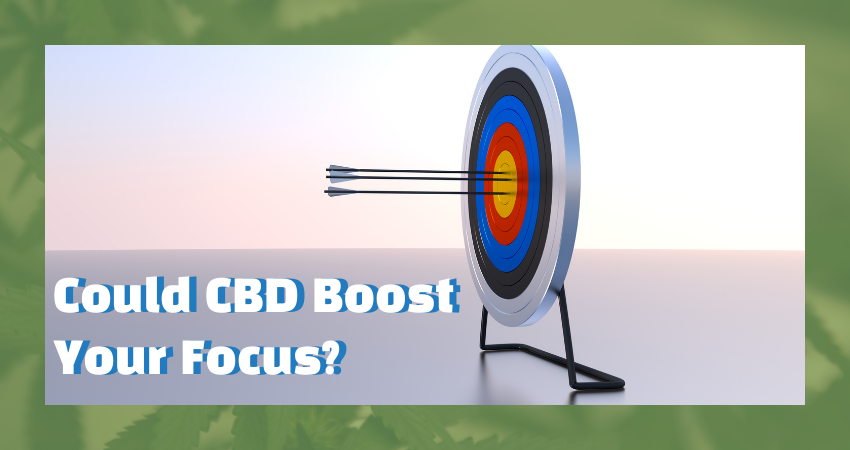
Jun 18, 2021 | CBD Solutions
Do you need to focus a little better? Need a little more mental oomph? Probably… Especially if you’ve been staying indoors like the rest of us. And if your reliance on caffeine has pushed you from 2 to 3 to 6 cups of coffee a day. It could be time for CBD. It may be one of the best natural ways to enhance your concentration and boost your focus. Here’s why!
CBD 101
CBD is a cannabinoid, a plant compound that’s considered hemp’s most important “ingredient.” CBD activates the human body’s endocannabinoid system, which leads to all sorts of natural health benefits.
(In a recent article we honed in on some of CBD’s most common benefits. Check it out if you haven’t already!)
One of CBD’s positive effects is to reduce inner stress. By doing this, CBD may be able to help your body overcome the outer stresses and strains that come its way. That includes the stress of distractions.
CBD vs. Distractions
In 2013, Salon declared that email is killing us—and things have only gotten worse since then. Between the sway of our social media accounts and the near-omnipresence of our phones, our brains are tempted and lured away from work almost constantly. Even leading researchers have resorted to calling the weaker parts of our psychology our “monkey mind.”
The human brain wasn’t really built for the modern world. You can try to set yourself up for success by creating the perfect work environment or following a morning ritual. That might work for a while. But ultimately, trying to overcome the brain’s built-in weaknesses by brute force is akin to trying to swim upstream.
A better solution might be to set up your brain for success by optimizing its chemistry. Scientists call this type of chemistry neurochemistry or biochemistry. Just think: instead of fighting off distractions on the macro level, why not promote concentration on a molecular level?
This type of molecular optimization might be exactly what CBD does best. Studies have shown that CBD may ‘quiet down’ overactive reward pathways in the brain. Reward pathways that are associated with sugar intake or even cocaine addiction. Other observational studies in humans have associated cannabinoid intake with reduced alcohol intake, reduced opioid abuse, and even reduced waist circumference.
CBD and Fat Burning
You know how some people claim that bulletproof coffee, rich in MCT oil or butter, boosts their concentration and reduces their hunger? CBD’s metabolic effect may do something similar. Try it for yourself before your next work session. You might feel more energized and less distracted by food.
That’s because CBD may help your body get into what’s sometimes called fat-burning mode. While our bodies are always metabolizing some mix of carbohydrates, fats, and amino acids to fuel themselves, some energy sources are “cleaner-burning” than others. Studies have shown that CBD might increase the proportion of fuel that comes from fat—fuel that powers your brain with stable, clean-burning energy.
To really go the extra mile, combine CBD with a diet rich in healthy fats—like the keto diet. In addition to favoring fat-burning mode and all the cognitive benefits that come with it, this diet actually provides the precursors (i.e, building blocks) that form our body’s own endocannabinoids.
When it comes to optimal performance, CBD and focus could be a match made in heaven.
CBD can help you concentrate on what really matters and stay productive. CBD capsule products may also deliver extra-long-lasting benefits. CBD can even be mixed into the coffee we kept mentioning earlier—far from being bad, moderate coffee intake has a wide variety of health benefits that improve when combined with CBD.
Better yet, compared to other popular concentration-boosting substances (caffeine, coffee, or even prescription drugs), CBD is remarkably free from side effects. It’s also one of the few substances that boosts concentration while simultaneously reducing feelings of anxiousness. It’s basically the high performer’s best friend!
Summing Things Up
Well, there you have it. CBD really could enhance focus. And it seems to do so holistically, working with your body through a variety of natural pathways.
The only unknown in our minds is what other benefits you might experience alongside CBD’s cognitive boost. Here’s to finding out!
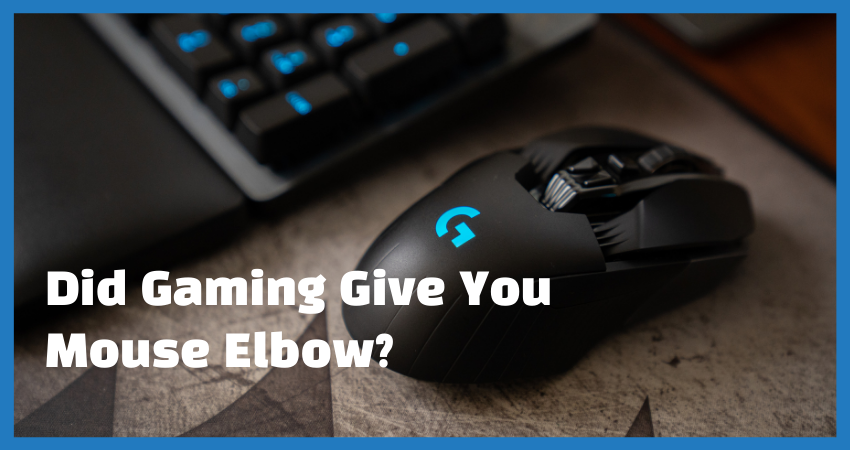
Apr 16, 2021 | Gaming and Your Body
How to Treat Mouse Elbow
Mouse Elbow… it’s a Thing
So what exactly is mouse elbow? Also known as lateral epicondylitis, it refers to inflammation in the extensor tendons of your forearm. It may also include inflammation in the extensor muscles that allow your hand to open and your wrist to bend [1, 2]. People who constantly use a computer mouse, like avid gamers or eSports professionals, are more susceptible to this type of injury.
The Anatomy of a Mouse… Elbow
To get a better understanding of how this condition develops, it’s important to learn about the anatomical structure of the forearm, hand and wrist. The tendons affected by mouse elbow are collectively known as the common extensor tendon. It consists of four muscles and tendons that join in one area called the lateral epicondyle. Additional structures that may be involved include:
- The extensor digitorum
- The extensor digiti minimi
- The extensor carpi ulnaris
- The extensor carpi radialis brevis
- The extensor carpi radialis longus
- The supracondylar ridge
These structures enable fine motor movements of the fingers, hands, wrist and forearm. The tendons and muscles also extend into the elbow region. Gaming and eSports enthusiasts develop mouse elbow after repeatedly holding and pressing mouse buttons while moving their arm. This causes the extensor tendons and muscles to constrict and contract repeatedly, leading to pain in the common extensor tendon (the outer region of the elbow) that may extend toward the forearm, wrist and hand [2]. This occurs because over time, repetitive gaming motions weaken and tire the extensor muscles and tendons in the forearm. These motions include gripping, squeezing and shifting a mouse, as well as pressing controller buttons or using a scroll wheel. If mouse elbow is left untreated, it can lead to the degeneration of collagen, a structural protein that supports connective tissue in the common extensor tendon [1-3].
The Symptoms
Symptoms of mouse elbow include…
- Pain in the outer elbow area
- Pain in your wrist when gripping or squeezing the mouse
- Pain bending your fingers or wrist backward (this contracts extensor muscles)
- Pain while flexing your fingers and wrist forward (this stretches extensor muscles)
- A weakened grip due to constant pain while gaming
Prevention Methods and Treatment
Here are a few strategies that can help treat mouse elbow and prevent it from worsening.
- Rest the affected arm so it has time to heal
- Gradually try strengthening and mobilizing exercises to improve circulation and muscle tone [4]
- Work with a specialist to make sure you’re performing these exercises properly [5]
- If you think you have mouse elbow, seek treatment right away, before it gets worse
Addressing mouse elbow early is the key to getting back into the game!
References
- Kahlenberg CA, et al. New Developments in the Use of Biologics and Other Modalities in the Management of Lateral Epicondylitis. Biomed Res Int. 2015; 2015: 439309.
- Andres BM, et al. Treatment of Tendinopathy: What Works, What Does Not, and What is on the Horizon. Clin Orthop Relat Res. 2008;466(7):1539-1554.
- Calfee RP, Patel A, DaSilva MF, Akelman E. Management of lateral epicondylitis: current concepts. Journal of the American Academy of Orthopaedic Surgeons. 2008;16(1):19-29.
- Croisier JL, Foidart-Dessalle M, Tinant F, Crielaard JM, Forthomme B. An isokinetic eccentric programme for the management of chronic lateral epicondylar tendinopathy. Br J Sports Med. 2007;41:269-275.
- Smidt N, van der Windt DA, Assendelft WJ, Deville WL, Korthals-de Bos IB, Bouter LM. Corticosteroid injections, physiotherapy, or a wait-and-see policy for lateral epicondylitis: a randomised controlled trial. Lancet. 2002;359:657-662.

Feb 12, 2021 | CBD Solutions
After bursting onto the scene in 2018, CBD has only kept getting more popular. It’s gathered a grass-roots reputation for promoting health and wholeness — customers report that CBD has them feeling better, thinking better, and sleeping better than they have in years.
In this article, we’ll be taking a closer look at all these benefits…and much more. Here’s an outline of what you can expect to read about:
- What is CBD?
- How is CBD Different from THC?
- CBD vs. Stress
- CBD vs. Inflammation
- CBD vs. Chronic Pain
- CBD and Sleep: Why It Could Work
What is CBD?
To put it super simply, CBD is a plant compound. What’s a plant compound? It’s a compound that’s important to a plant’s life cycle and metabolic health, of course!
In the case of CBD, the plant in question is called hemp. And while hemp’s CBD content fulfills several important metabolic roles within the plant, it also fulfills several important roles within us humans.
CBD is also an acronym that stands for canna bi diol. Its full name denotes its chemical structure, but it’s also a little awkward to say, so CBD’s shorter name has stuck.
How is CBD Different from THC?
If “location, location, location” is the clarion call of real estate, “sourcing, sourcing, sourcing” might just settle the question of CBD quality. Why’s that? Because good hemp creates good CBD products, and CBD sourced from industrial hemp is fully legal in all 50 states.
Sourcing also highlights the main difference between CBD and THC, another well-known cannabinoid. While CBD is hemp’s most active ingredient, THC is marijuana’s most active ingredient.
Compared to ‘normal’ marijuana/cannabis, hemp contains lots of CBD and very little THC. Federal law specifies: industrial hemp must contain .3 % THC or less. That’s not very much!
This unique cannabinoid ratio of high CBD and low THC means that hemp’s CBD content can gently regulate the body without causing any weird side effects. In other words, CBD provides health benefits without the ‘high.’
CBD vs. Stress
Speaking of CBD’s health benefits, most of them actually stem from something very simple:
CBD’s ability to reduce stress. By helping various parts of your body communicate with each other, CBD may silence stress and promote full-body balance.
This might sound a little metaphysical, but it’s actually real science. CBD activates a system called the endocannabinoid system, and this system provides an ongoing checks-and-balances type effect to virtually every other physiological system and vital organ in your body. That means CBD may help your body operate efficiently — efficiently enough to stay above the equilibrium that is poor health and reduced immunity.
In short, CBD = improved endocannabinoid system function = reduced stress.
The implications of this concept are nearly endless. Pioneering endocrinologist Hans Selye found that non-specific stressors can manifest themselves in a wide variety of ways; stress can crush a person’s posture or wreck their circadian rhythm or steal the glow from their face. Conversely, reductions in stress can have different effects on different people.
Indeed, some people who take CBD find that they sleep better, while others notice no difference in their sleep but gain some much-needed mobility. Could CBD’s wide variety of health benefits be explained by this simple stress-reduction concept? We think so.
With this pattern in mind, let’s take a more specific look at some of CBD’s most common health benefits.
CBD vs. Inflammation
The human body is complex enough that nearly everything that happens within it is dependent on context.
A little bit of inflammation is a good thing, but chronic inflammation can begin to eat away at tissues and cause degeneration if left unchecked. Many factors can influence inflammation, and some of them are unexpected: even the foods we eat provide the building blocks for inflammatory molecules. Unfortunately, the modern western diet is full of both the omega-6 fats that fuel the creation of these molecules…and the allergenic proteins that send them off.
Hey, we get it: avoiding these problem foods can be tough. The good news is that CBD’s here to help! CBD may shift your inflammatory balance to a healthier place by reducing the rate at which interleukins and other inflammatory molecules are produced. It may even work with the endocannabinoid system to reduce the need for inflammatory reactions in the first place.
“It has been suggested that CBD may indirectly improve anti-inflammatory effects,” one study deduced. CBD may also act as an antioxidant, which makes sense given inflammation and oxidation often go hand in hand. Both these effects have all sorts of nice ‘downstream’ benefits…
CBD vs. Chronic Pain
Reduced pain is one of the biggest benefits many CBD users notice. Even super-stubborn chronic pain often fades with consistent CBD use. Key word being consistent. CBD can only reduce inflammation and pain if it’s taken consistently over time. You’ll likely need to take more CBD the higher your pain levels are.
But don’t feel hopeless if your pain has you feeling like you need relief right now. That’s what topical CBD is for! There’s some evidence that applying topical CBD can blunt your brain’s perception of pain almost instantly.
You know how hot peppers make your mouth feel like it’s burning, even though it not actually on fire? CBD works via the same TRPV1 sensory pathway in the opposite way, making your joints feel like they’re not inflamed — long before CBD’s actual anti-inflammatory benefits begin to kick in.
If you want to get the best of both worlds, the solution is simple: take CBD oil consistently each day and add a CBD topical into the routine if/when you really need it. And have hope. CBD for chronic pain can really work! Some doctors are even using it to wean their patients off conventional NSAIDs and opioids.
CBD and Sleep: Why It Could Work
Another favorite benefit of many of our new customers? Improved sleep.
Unlike conventional sleep aids, however, CBD doesn’t normally make you sleepy during the day. Instead, it may work with your body’s built-in circadian clock to make you feel tired when you want to — at night! One of America’s largest CBD case studies yet found that the compound might work for both sleep and anxiety.
If you’ve been depending on melatonin, alcohol, or other substances to help you unwind in the evening, consider switching over to CBD. It has considerably fewer side effects…and it might just work better anyways. Why take supplemental melatonin when your endocannabinoid system can help your body produce the melatonin it needs to produce, naturally? (That’s a rhetorical question, of course.)





